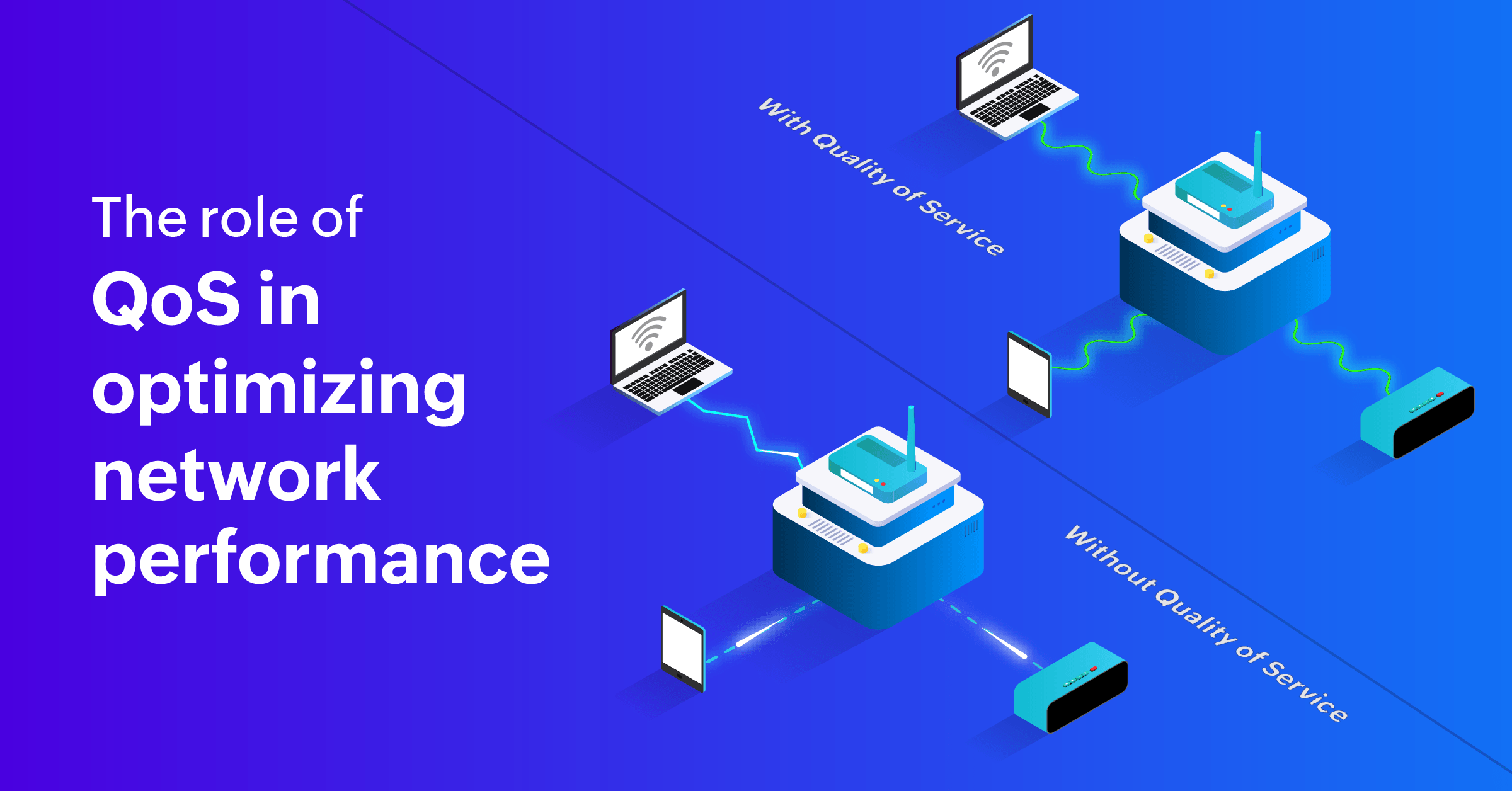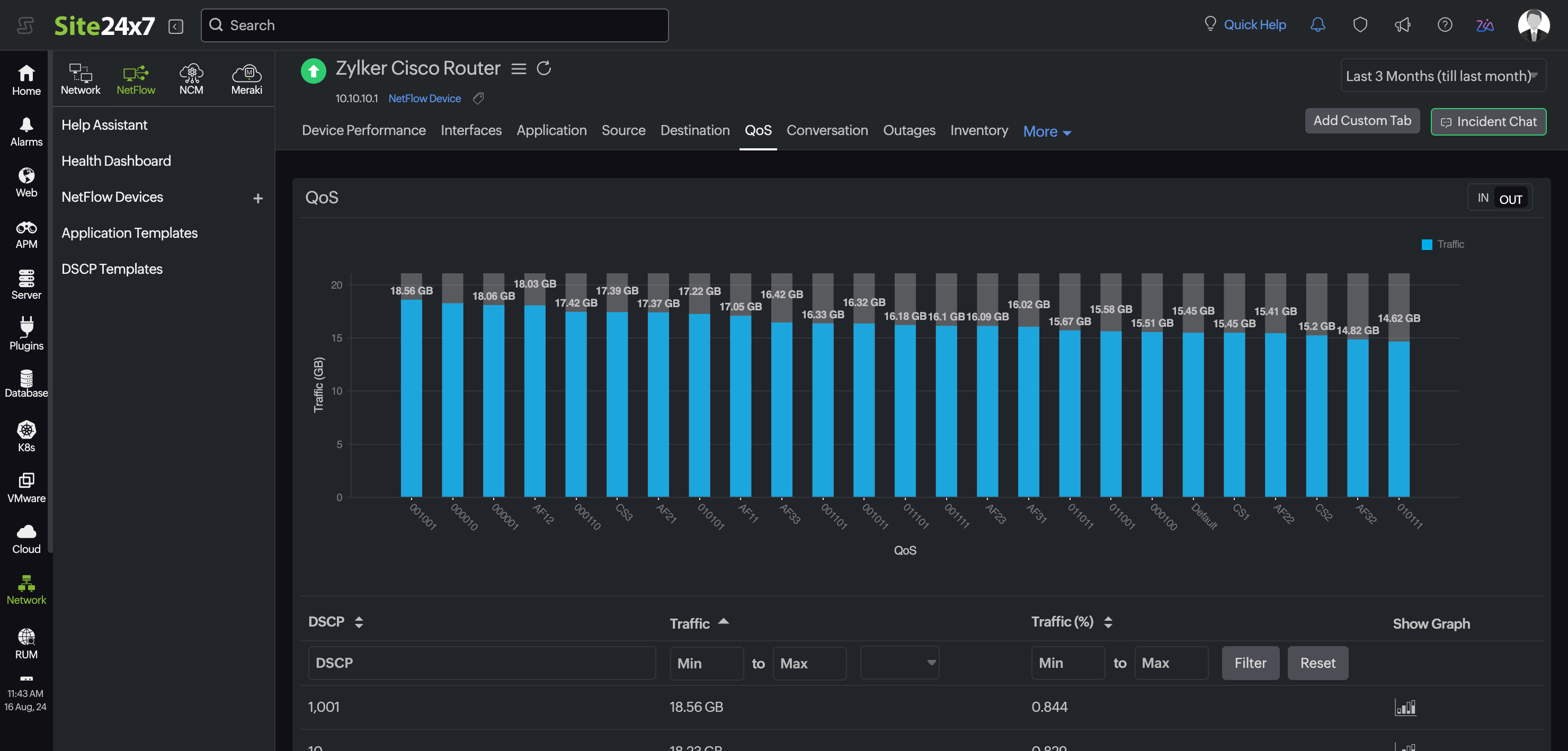The role of QoS in optimizing network usage

As businesses heavily depend on the internet and network services for daily operations, the performance and reliability of these networks are key to their success. This highlights the crucial role of quality of service (QoS) in improving network efficiency. It ensures a smooth user experience and supports business advancement. In this blog, we'll focus on how QoS significantly optimizes network performance, demonstrated through a detailed use case.
What is QoS in networking?
QoS involves using technologies and strategies to manage network resources effectively. Its main goal is to guarantee that key applications like VoIP, video conferencing, and cloud services receive the bandwidth and resources they need for seamless operation. Through traffic prioritization, bandwidth management, and congestion reduction, QoS ensures top performance for critical services.
The impact of QoS on network optimization
Traffic prioritization
A core function of QoS is prioritizing different types of network traffic. This feature allows applications requiring real-time or near-instantaneous communication, like VoIP or live streaming, to run smoothly by minimizing latency and jitter.
Bandwidth management
Through QoS, bandwidth is allocated strategically according to the importance of applications, ensuring that vital services operate efficiently without overloading the network.
Latency reduction
QoS mechanisms prioritize real-time applications such as VoIP or video conferencing, reducing latency and enhancing the quality of communication and collaboration.
Enhanced user experience
Ultimately, QoS measures aim to elevate the user experience by offering uninterrupted, high-quality network service, particularly for priority applications.
Cost savings
Effective QoS implementation can help businesses optimize network resources, reduce downtime, and avoid potential revenue losses due to network inefficiencies.
Integrating with monitoring tools
Integrating network traffic monitoring and network configuration management plays a pivotal role in further improving QoS in network management. These strategies offer additional insights and control, enabling businesses to optimize their networks more effectively beyond basic QoS practices.
Enhancing QoS with network traffic monitoring
Network traffic monitoring involves the continuous observation and analysis of data flowing over a network. This process provides real-time visibility into the type, source, destination, volume, and movement of data packets.
Here's how network traffic monitoring can help enhance QoS:
- Identification of traffic patterns: By analyzing network traffic, businesses can identify usage patterns and trends. This information is invaluable for QoS, as it allows for the realignment of priorities based on actual data flow and application requirements.
- Detecting congestion and bottlenecks: Traffic monitoring helps detect congestion and bottlenecks early on, which can degrade network performance. Recognizing these issues in real time enables swift mitigation strategies, ensuring priority services remain unaffected.
- Performance benchmarking: Establishing performance benchmarks through monitoring allows businesses to measure the effectiveness of their QoS strategies. It makes the impact of any adjustments to QoS policies directly observable, facilitating ongoing optimization.
How network traffic monitoring in Site24x7 helps track QoS
In Site24x7, you can track the QoS according to each device or even each interface. Simply click the device and navigate to the QoS tab to view the traffic according to the differentiated services code point (DSCP). You can even click an interface in the Interfaces tab to view the QoS details for that interface.

Optimizing QoS with network configuration management (NCM)
NCM involves maintaining, tracking, and documenting network devices' configurations. Implementing it alongside QoS provides several benefits:
- Consistency in QoS policies: Configuration management ensures that all network devices adhere to established QoS policies. This consistency is crucial for maintaining desired quality levels across the entire network, especially in complex environments with numerous devices.
- Efficiency in policy implementation: A centralized configuration management approach allows updates or changes to QoS policies to be rolled out quickly and uniformly. This efficiency minimizes the risk of misconfigurations that could negatively affect network performance.
- Mitigation of configuration errors: Configuration management allows for the tracking of changes and the ability to revert to previous configurations if a new setup causes issues. This capability is vital in maintaining QoS by swiftly addressing any unintended consequences of configuration adjustments.
Site24x7 enables you to apply configuration changes across multiple devices using configlets. Organizations can create a configlet to automate the process of checking if QoS requirements are met in existing devices after a configuration change or when adding new devices. The configlet is then automatically applied to the devices, ensuring that QoS conditions are maintained.
These integrations between QoS, network traffic monitoring, and NCM offer a comprehensive approach to maximizing network efficiency and reliability. The ability to monitor traffic flow and manage network configurations enhances the effectiveness of QoS policies, ensuring that mission-critical applications receive the necessary bandwidth and resources. Consequently, businesses can not only provide an improved user experience but also benefit from significant operational advantages, aligning with the strategic goal of leveraging technology for success in the digital era.
Implementing QoS: A real-world use case
To understand the practical benefits of monitoring QoS, let's consider a global corporation with a footprint that spans continents. This enterprise depends on VoIP and video conferencing for both internal dialogs and client engagements. The company faces persistent issues with call drops, degraded video quality, and noticeable delays during high-traffic periods, resulting in a downturn in productivity and client satisfaction.
In such scenarios, network administrators should conduct a thorough network analysis to reveal the root causes of the issues. These could include a lack of traffic prioritization or bandwidth mismanagement, insufficient network traffic monitoring, and lax network configuration management. To address these challenges, the corporation should implement a comprehensive QoS framework coupled with rigorous network traffic monitoring and agile network configuration management strategies that include network automation using configlets.
The enhanced QoS framework allows for the establishment of policies that prioritize VoIP and video conferencing traffic. Network traffic monitoring helps continuously observe and analyze the flow of data, enabling real-time adjustments and preemptive action to avert potential performance bottlenecks. Meanwhile, NCM ensures that changes in network settings are systematically controlled and documented, reducing downtime and ensuring that the network always operates in an optimal state.
These initiatives collectively transform any organization's operational efficiency. In most cases, call quality shows a marked improvement, video conferencing sessions proceed without disruptive interruptions, and overall employee productivity is given a significant boost.
Improving network reliability through a comprehensive QoS approach
This refined example underlines the critical importance of a holistic approach to QoS, incorporating not just traffic prioritization and bandwidth allocation but also continuous network monitoring and adept configuration management. By wielding these elements together, businesses can significantly enhance network performance and reliability, ensuring a seamless and high-quality user experience. In an era marked by increasing dependence on digital infrastructure, the strategic implementation of such comprehensive network management practices, including QoS, stands as a key pillar in navigating and thriving amid the complexities of the digital landscape.
Comments (0)